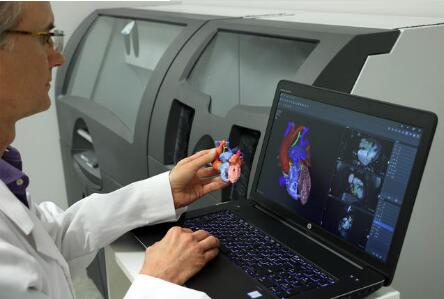3D Systems Draws on Healthcare Expertise to Deliver FDA Cleared D2P™
3D Systems (NYSE:DDD) announced on September 12 it received additional 510(k) clearance for its D2P™ (DICOM-to-PRINT) software allowing clinicians to 3D print diagnostic patient-specific anatomic models. 3D Systems is the only company to offer a solution that combines its own software and printers to create 3D printed patient-specific anatomic models for diagnostic purposes in an unmatched breadth of medical specialties including: cardiovascular, craniofacial, gastrointestinal, genitourinary, neurological, and musculoskeletal applications. D2P relies on unique automatic segmentation tools driven by deep learning that allow medical practitioners to quickly create accurate, digital 3D anatomic models from medical imaging data. With the additional FDA clearance, D2P addresses the growing demand by point of care (POC) institutions for in-house manufacturing using an accurate and reliable 3D segmentation solution that can produce 3D printed models.

D2P now also includes the latest advancements in deep learning image processing technology and virtual reality visualization allowing hospitals and device manufacturers to significantly reduce the time associated with the creation of 3D models.
The software also includes a volumetric VR solution enabling instant views of patient scans in a 3D environment – facilitating surgical planning and conversations between medical staff and their patients.
“We are used to going into surgery with uncertainties and an arsenal of contingency plans,” said Dr. Solomon Dadia, deputy director of the orthopedic-oncology department and director of the 3D surgical center at Souraski Medical Center in Tel-Aviv. “With 3D printed models and enhanced 3D visualization tools such as VR, we are able to gain a better understanding of the surgery and pathology we are going to treat. This allows us to come up with a more precise surgery plan designed to deliver a better surgical outcome.”
In accordance with the FDA announcement on new guidelines for 3D printed patient-specific anatomic models in 2017, diagnostic quality models must be an output of a Class II regulated medical device software. 3D Systems is the only company to offer both a software solution and compatible printers of its own that meet this regulatory requirement. Anatomic models can be produced using a variety of 3D Systems printing technologies – ColorJet Printing, MultiJet Printing, Stereolithography, and Selective Laser Sintering – including materials that are capable of sterility and biocompatibility.
“The capabilities offered in D2P give the healthcare professional an unprecedented toolset for deeper medical understanding across most medical specialties,” said Ran Bronstein, vice president, chief research and operation officer, 3D Systems. “Our proprietary advanced visualization technology is changing how medical imaging data is used in a variety of formats such as virtual reality and 3D printed physical models.”
Source: 3D Systems




Recent Comments